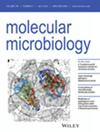Autophagy and the Mitochondrial Lon1 Protease Are Necessary for Botrytis cinerea Heat Adaptation.
IF 2.6
2区 生物学
Q3 BIOCHEMISTRY & MOLECULAR BIOLOGY
引用次数: 0
Abstract
Heat adaptation is a multilayered universal process involving a coordinated response of general and heat-specific cellular systems and processes. Here, we demonstrate that adaptation of the plant pathogenic fungus Botrytis cinerea to mild heat stress requires both autophagy and the mitochondrial Lon1 protease. Deleting bclon1 or blocking autophagy by deleting the bcatg1 autophagy-regulating gene did not affect fungal survival at optimal temperature. Under heat stress, deletion of bclon1 induced earlier and more intense autophagy, mitochondrial malfunction, and accelerated fungal cell death. These phenomena were intensified in a bcatg1/lon1 double mutant, indicating coordinated activity of both pathways in heat adaptation. Blocking autophagy, but not bclon1, also affected mycelia growth, spore germination, as well as nuclei division and spore morphology. Our results support a cytoprotective role for autophagy downstream of mitochondria-driven death signals, possibly as a mechanism that promotes growth arrest and helps remove damaged cellular components.灰葡萄孢热适应需要自噬和线粒体Lon1蛋白酶。
热适应是一个多层次的普遍过程,涉及一般和热特异性细胞系统和过程的协调响应。在这里,我们证明了植物病原真菌灰葡萄孢(Botrytis cinerea)对轻度热胁迫的适应既需要自噬,也需要线粒体Lon1蛋白酶。删除bclon1或通过删除bcatg1自噬调节基因来阻断自噬并不影响真菌在最佳温度下的存活。在热应激条件下,bclon1的缺失会导致更早、更强烈的自噬、线粒体功能障碍和加速真菌细胞死亡。这些现象在bcatg1/lon1双突变体中得到加强,表明这两种途径在热适应中协同活动。阻断自噬作用对菌丝生长、孢子萌发、细胞核分裂和孢子形态也有影响,但不影响bclon1。我们的研究结果支持线粒体驱动的死亡信号下游自噬的细胞保护作用,可能作为促进生长停滞和帮助去除受损细胞成分的机制。
本文章由计算机程序翻译,如有差异,请以英文原文为准。
求助全文
约1分钟内获得全文
求助全文
来源期刊

Molecular Microbiology
生物-生化与分子生物学
CiteScore
7.20
自引率
5.60%
发文量
132
审稿时长
1.7 months
期刊介绍:
Molecular Microbiology, the leading primary journal in the microbial sciences, publishes molecular studies of Bacteria, Archaea, eukaryotic microorganisms, and their viruses.
Research papers should lead to a deeper understanding of the molecular principles underlying basic physiological processes or mechanisms. Appropriate topics include gene expression and regulation, pathogenicity and virulence, physiology and metabolism, synthesis of macromolecules (proteins, nucleic acids, lipids, polysaccharides, etc), cell biology and subcellular organization, membrane biogenesis and function, traffic and transport, cell-cell communication and signalling pathways, evolution and gene transfer. Articles focused on host responses (cellular or immunological) to pathogens or on microbial ecology should be directed to our sister journals Cellular Microbiology and Environmental Microbiology, respectively.
 求助内容:
求助内容: 应助结果提醒方式:
应助结果提醒方式:


